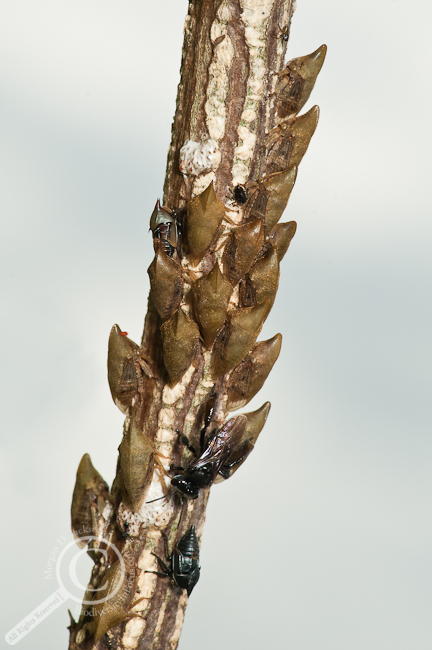
It’s been an interesting week for entomology, and I wanted to share a few of the highlights. Conveniently enough, I had a photo which nicely segues between each of the stories!
One of the dominant aspects of the photo is the aggregation of subsocial treehoppers (Membracidae, genus Aconophora). Membracids are one of the more intriguing bugs, with their large thoracic shields which have diversified into shapes and sizes ranging from the thorn like appendages seen here, to shapes mimicking ants or wasps. But how did the treehopper get its shield? A new paper published in Nature provides solid evidence for the evolutionary origins, and the results just may surprise you. The topic has been covered extensively in the science/ento blogosphere, so I’ll provide the links (in no particular order) and you can chose which synopsis you like the best; they’re all excellent!
- From 250 million years of repression, a wonderland of hats – Ed Yong, Not Exactly Rocket Science
- The strange origin of the treehopper “helmet” – Jerry Coyne, Why Evolution is True
- Hoppers, Hats, and Homology (with video link) – Bug Girl, Bug Girl’s Blog
- (Spoiler Alert) The astounding shapes of treehoppers evolved from wing-like appendages – Alex Wild, Myrmecos
Our next highlight ties into the lone stingless bee (Apidae, tribe Meliponini, maybe genus Trigona) roving around the mass of treehoppers. I saw many individuals clambering around the mass of ‘hoppers while I tried to get a photograph without falling down the hill this plant was growing on in northwestern Costa Rica. The treehoppers didn’t seem to mind the intrusion, and I suspect the bees were gathering the sweet honeydew droppings produced by the treehoppers. All tangents aside, where am I going with this? Well there’s a new documentary scoring high marks on the festival scene which features a cousin of these bees, the European Honey Bee (Apis mellifera) and its marked decline in recent years. Featuring interviews with what appear to be several eccentric apiculturists and entomologists, Queen of the Sun – What are the bees telling us? sheds some light on the various factors affecting honeybee populations and what the future may hold for these economically important pollinators. Take a second to check out the trailer:
While not likely to see a wide distribution, there are plenty of opportunities to see this movie. There will even be a 3 day engagement at the Bookshelf Cinema here in Guelph from May 24-26 (I’ll be there and providing a review, no worries). Check the screenings list to find a location near you!
So what’s the final tidbit and how does it tie into the photo? Well, that’s a photo of insects, and potentially one I could enter into the 2nd annual Bug Eye photo contest being held by the Entomological Society of Ontario! If you have photos of insects (or related arthropods) and wouldn’t mind winning $50, why not consider entering them? With 3 categories for you to choose from (Ontario Insect, Ontario Resident (Photographer), and a general Open category), a cash prize for each category (in CDN$, so that’s like $52.00US for once!), and the chance to have your photograph prominently displayed at the ESO Annual General Meeting next fall, there is plenty of incentive to enter. Check out the full contest details here and please consider entering your favourite photos!
That does it for this link roundup, which is a good thing as I’m out of content relevant to that photo! Guess I’ll need to find another photo for the next busy week…

Thanks for the heads up as always Morgan! You should definitely enter this competition – wish you a good luck! Also, is there a tiny insect/arachnid just above the very first Hemipteran to the right?
Thanks for the good luck, but I’m actually acting as one of the judges, so there might be a bit of a conflict of interest there… but I strongly encourage you to submit your photos to the contest!
That little blob is actually an early nymphal stage of the species. As far as I can tell there are 4 instars represented here plus the adults (the norm for treehoppers is 5 instars I believe).
That’s great! I will definitely send in a few photograps!h
Too bad you’re a judge – that’s a great photo!